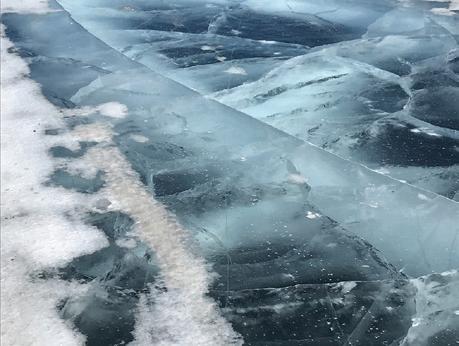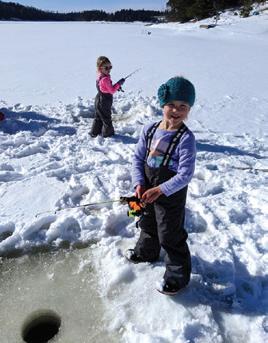
4 minute read
Lake ice needs our care
BY ROSEMARY ROBERTSON
There is magic in the winter ice. It is remarkable to walk on a surface that but a few weeks ago, you couldn’t. It is serene most days. You see with new eyes amazing scenery that you are familiar with in summer. Different pursuits await. One of our favourites is to track animals that are dependent on lake ice in their search for food. Ice allows them a larger territory in which to hunt. Watching the food chain operate in winter is fascinating.
Advertisement
For the good of the lake, bring on the cold weather. The thicker the ice, the longer the spring melt. We may be anxious for spring to access our properties, but an earlier thaw plays havoc with lake ecology. Aquatic life relies on ice cover to reflect solar radiation to prevent overheating and reduce water loss through evaporation. We are all concerned about dropping water levels, which is becoming more prevalent as the climate heats up. For us humans, it is the inconvenience of high docks, exposed reefs and shallow submersible pumps. For aquatic life, it’s a matter of life and death. That makes the fight against pollutants and climate change imperative for lake lovers.
There are pressures on freshwater ecosystems that are of our own creation. Those burdens challenge the integrity and sustainable use of these resources. Ice that has been corrupted in any way can contaminate ice water. We value clean, safe water drawn from our lakes that were ice covered. We appreciate access to lakes and rivers for recreational use.
Sadly, it seems the adage “leave no trace” disappears from some people’s vernacular in winter. A growing number of individuals who use the ice for pleasure or livelihood forget that looking after lake ice carefully will enable perpetuation of their chosen activity.
Jim and I spend a lot of time walking the ice road and through the bush in winter. We always take a garbage bag with us, and it never comes back empty. Lunch garbage, replaced car windshield wipers, treated wood, parts off vehicles, cans and plastic bottles of all kinds are in great profusion. One day, we found the remnants of a truck bed of garbage shovelled out onto the ice. The lake is not a bottomless pit that will absorb everything that is on it come spring. We hope others will see us picking up junk and think twice about dropping their coffee cups out the window when travelling the ice roads.

Ice Fishing on the Winnipeg River is a privilege for Livia (L) and Lennon (r) Cain.
Our other abundant find is dog feces. I can’t think of a better place in winter to let Fido run and play on the ice. Unfortunately, some owners take the “out of sight, out of mind” approach. Many just let their dogs relieve themselves on the ice. Others forget poop bags at home or leave them filled along the edge of the road.
Dog feces does not break down as does wild animal feces due to dog diets. When it enters the water through melting it becomes problematic for humans and other organisms that contact the water. E. coli and salmonellae are two of the dog feces bacteria and parasites like roundworms and hookworms can be present. Dog doo-doo deserters may not be aware that fecal matter adds nutrients to the lake. Nutrients create blue-green algae blooms and other water quality problems. This may lead to drinking water loss, restrictions on what we can do in the water and limitations in where fish can live. Break out the baggies for all excrement, canine and human. Please take it to land where it can do no harm to the water.
With increased use of the ice as a highway by vehicles, comes a lot of debris not meant to be there. Piles of dirty snow from vehicles’ undercarriages are everywhere. Vehicles parked on the ice have either had these accumulations intentionally kicked off or they melt and fall off. The contents of those lumps contain additives from our roads, primarily salt and sand. The salt doesn’t disappear when ice and snow melts. It dissolves into sodium and chloride ions. Chloride is the issue for aquatic species. Salt can be deadly for birds and other wildlife if ingested. It makes sense to wash off the piles of sludge before you leave town.
Gathering around an outdoor fire with friends in winter is wonderful. Be it at a lake skating rink or ice shack, fires provide warmth and an opportunity to cook food. However, fires burnt directly on the ice can be harmful. Ash left behind can sink down and coat the bottom when ice melts. This can contaminate spawning beds. It’s wise to burn in a portable fire pit or incinerator and to take the ash with you in a fire proof container.
These are all small steps we can take while enjoying time on the ice to protect the waterways we welcome come spring.
Meet you there!










